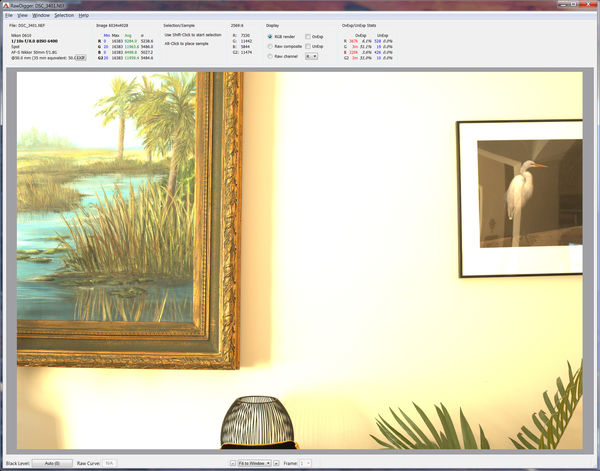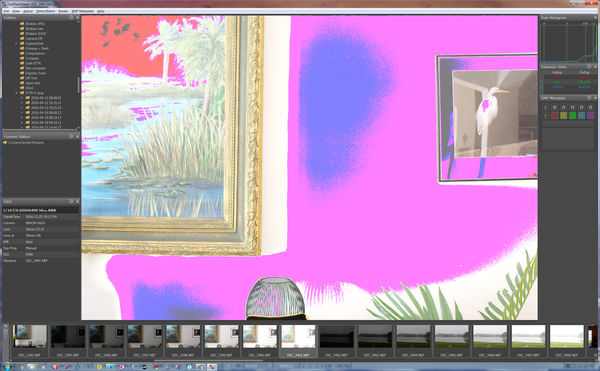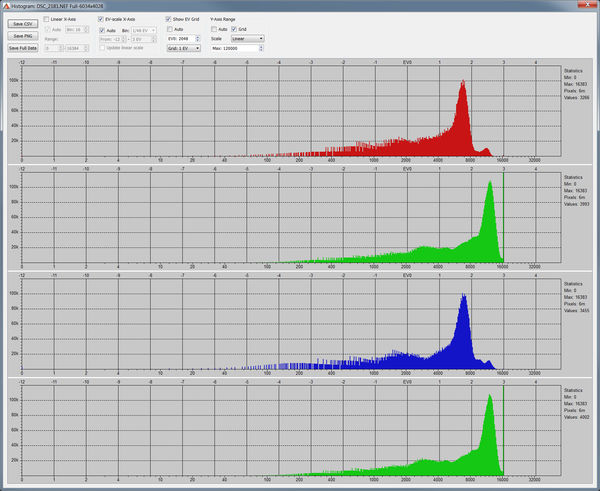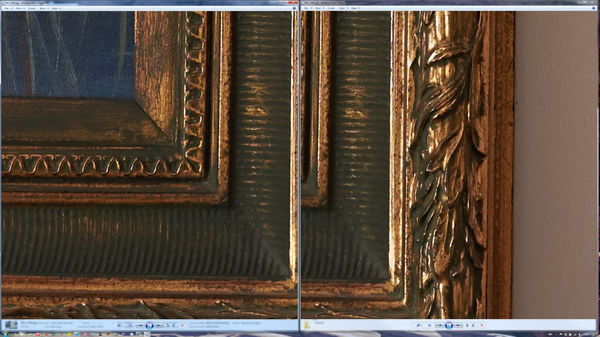What is the Camera's Dynamic Range?
Feb 10, 2017 10:38:48 #
selmslie wrote:
... I know the answer but can he figure it out?
Not yet apparently.
In the meantime Uuglypher might like to examine the attached image. It is a crop of the first and sixth images in the group since the seventh is overexposed. There is a little noise but changing the ISO from 100 to 3200 did not alter that because the exposure was constant so the S/N did not change.
The scene had a DR of 5 stops based on the RawDigger histograms. I was able to use a range of ISO from 100 to 3200 (5 more stops). In effect, the camera has a DR of at least 10 stops.
It's pretty clear from this demonstration that a scene with a DR of 5 stops with this camera does not require ETTR or EBTR to fix anything - neither noise nor shadow tonality. This should be obvious to anyone with an open mind and no ax to grind.
This is a 400% enlargement so it won't put a strain on anyone's visual acuity.
Feb 10, 2017 16:21:46 #
It's safe to assume that Uuglypher can't figure this out or is embarrassed by what he has learned here.
For those of you who have been patient enough to stick around I will tell you the rest of the story, as Paul Harvey used to say.
Since I didn't have a copy of RawDigger back in December when I posted the series on page 2, I did not have a heads-up on the problem with the seventh image. RawDigger or FastRawViewer would have made it obvious (see the images below) and I might have redone the series with an extra stop of exposure.
In the RawDigger web page it states, "RawDigger is not a raw convertor[sic]. Instead, it allows you to see the data that will be used by raw convertors."
FastRawViewer, from the same vendor, lets you see the highlight warnings to let you know what part of the image is going to need to be rescued by the converter (pink) and which areas are so far blown (purple and gray) that rescue might not be possible.
But Capture One is a fullly functional raw converter. It was able to rescue the blown highlight areas and render them with a semblance of reasonable color. Probably most other competent raw converters would have done as well.
Nevertheless, it's better not to press your luck. A raw converter might lull you into a false sense of security by trying to clean up after a mess you make with too much exposure.
ETTR is safe and effective.
An extra 1 or 1-1/3 stop of exposure at or near base ISO does not buy you much, if anything.
EBTR can be risky.
For those of you who have been patient enough to stick around I will tell you the rest of the story, as Paul Harvey used to say.
Since I didn't have a copy of RawDigger back in December when I posted the series on page 2, I did not have a heads-up on the problem with the seventh image. RawDigger or FastRawViewer would have made it obvious (see the images below) and I might have redone the series with an extra stop of exposure.
In the RawDigger web page it states, "RawDigger is not a raw convertor[sic]. Instead, it allows you to see the data that will be used by raw convertors."
FastRawViewer, from the same vendor, lets you see the highlight warnings to let you know what part of the image is going to need to be rescued by the converter (pink) and which areas are so far blown (purple and gray) that rescue might not be possible.
But Capture One is a fullly functional raw converter. It was able to rescue the blown highlight areas and render them with a semblance of reasonable color. Probably most other competent raw converters would have done as well.
Nevertheless, it's better not to press your luck. A raw converter might lull you into a false sense of security by trying to clean up after a mess you make with too much exposure.
ETTR is safe and effective.
An extra 1 or 1-1/3 stop of exposure at or near base ISO does not buy you much, if anything.
EBTR can be risky.
As seen in RawDigger

(Download)
As seen in FastRawViewer with highlight warnings turned on

(Download)
Feb 11, 2017 14:38:44 #
Well, Selmslie, I thought I'd check to see your response to the comparison sample I sent you.
They were, in fact, both exposed at ISO 6400 (according to your stated exposures when you posted the images on April 29, 2016.)
The point was to emphasize, with your own images, the effect of use of increased DR on capture of noise (significantly decreased) and rendition of shadow detail (detectably increased). Certainly understandable, given that the actual difference between the two images was that the longer exposure utilized 7 more stops of available dynamic range.
The fact remains, of course, that, regardless of the ISO used, using more of the available dynamic range will, in every instance, result in capture of LESS NOISE than will occur with use of less of the available DR. You, of course,(having frequently stated that the benefits of EBTR are to be realized only with "base ISO") resort to tortured pseudo-technical discourse to cover your tracks.
Bottom line?
The fact remains that whatever your chosen ISO for raw image data capture, ALWAYS use the maximum available dynamic range offered by your particular camera to assure maximum image data quality. To argue otherwise is arrant nonsense!
It is interesting that your frequent claims that "ETTR and EBTR have outlived their usefulness" seem related solely to their utility in reducing captured noise. Indeed, the newer sensors yield less noise with increased ISO, but certainly don't eliminate it. And you completely fail to acknowledge, in the face of abundant evidence to the contrary, the effect of full utilization of a sensor's DR on maximizing capture of available tonal and color spectra (with consequent increase in cusps of detail and thus improvement of discernible shadow detail) and maximizing the creative potential of a properly exposed raw image data file. It is intellectually dishonest to base your false claim of "out-dated ETTR or EBTR" solely upon reduction of capture of noise. And remember, reduced capture of noise is still of significance to the many users of digital cameras only four of five years old.
At the end of the day, it is strange that you still have not tumbled to the fact that, in contradistinction to proper exposure of JPEG files (and photosensitive emulsions), there is but one principle of proper exposure for ANY capture of raw image data to assure optimal image quality.
to wit: Expose to produce the brightest image possible, coming as close as possible to clipping highlights without actually doing so.
Do that, Selmslie, and you will have image data permitting perfect accomplishment of the image you visualized when you released the shutter... with a guaran-damn-tee of no clipped highlights and of having captured image data of the highest possible quality. If, however, you actually DO clip highlights, it is proof positive that you did not accurately determine your camera's full available dynamic range at the ISO employed.
Nothing could be simpler, Selmslie, than properly exposing a capture of raw image data...regardless of whether you are shooting in heavy overcast, fog, or brightly lit snow or bright beach scene in full sunlight!
If you find that it is inconvenient to properly expose raw image data captures, and are unable to perceive benefits in image quality resulting from full use of available DR, then simply continue to expose your raw captures in the same manner that you expose your JPEGs.
However, your strange, compulsive vendetta against consistent use of proper exposure of raw image captures is inexplicable to those of us who have found the minimal effort involved in learning appropriate raw exposure technique to be well repaid in significantly improved image quality (as can be seen not only in numerous submitted examples, but also in your own images sent, ostensibly, in negation of that fact.).
And by the bye, someone who cannot perceive the standard indices of optimal image data quality and who suggests that there is merit in not using a camera's full available amount of raw-accessible dynamic range and thereby forfeit as much as 50% to 75% of its tonal and color spectra is in a pitifully poor position to presume to subject anyone who promotes the highest standard of raw image capture exposure to any sort of "quiz".
Anyway, Selmslie, best of luck in your photographic endeavors, in whatever manner you choose to pursue them
They were, in fact, both exposed at ISO 6400 (according to your stated exposures when you posted the images on April 29, 2016.)
The point was to emphasize, with your own images, the effect of use of increased DR on capture of noise (significantly decreased) and rendition of shadow detail (detectably increased). Certainly understandable, given that the actual difference between the two images was that the longer exposure utilized 7 more stops of available dynamic range.
The fact remains, of course, that, regardless of the ISO used, using more of the available dynamic range will, in every instance, result in capture of LESS NOISE than will occur with use of less of the available DR. You, of course,(having frequently stated that the benefits of EBTR are to be realized only with "base ISO") resort to tortured pseudo-technical discourse to cover your tracks.
Bottom line?
The fact remains that whatever your chosen ISO for raw image data capture, ALWAYS use the maximum available dynamic range offered by your particular camera to assure maximum image data quality. To argue otherwise is arrant nonsense!
It is interesting that your frequent claims that "ETTR and EBTR have outlived their usefulness" seem related solely to their utility in reducing captured noise. Indeed, the newer sensors yield less noise with increased ISO, but certainly don't eliminate it. And you completely fail to acknowledge, in the face of abundant evidence to the contrary, the effect of full utilization of a sensor's DR on maximizing capture of available tonal and color spectra (with consequent increase in cusps of detail and thus improvement of discernible shadow detail) and maximizing the creative potential of a properly exposed raw image data file. It is intellectually dishonest to base your false claim of "out-dated ETTR or EBTR" solely upon reduction of capture of noise. And remember, reduced capture of noise is still of significance to the many users of digital cameras only four of five years old.
At the end of the day, it is strange that you still have not tumbled to the fact that, in contradistinction to proper exposure of JPEG files (and photosensitive emulsions), there is but one principle of proper exposure for ANY capture of raw image data to assure optimal image quality.
to wit: Expose to produce the brightest image possible, coming as close as possible to clipping highlights without actually doing so.
Do that, Selmslie, and you will have image data permitting perfect accomplishment of the image you visualized when you released the shutter... with a guaran-damn-tee of no clipped highlights and of having captured image data of the highest possible quality. If, however, you actually DO clip highlights, it is proof positive that you did not accurately determine your camera's full available dynamic range at the ISO employed.
Nothing could be simpler, Selmslie, than properly exposing a capture of raw image data...regardless of whether you are shooting in heavy overcast, fog, or brightly lit snow or bright beach scene in full sunlight!
If you find that it is inconvenient to properly expose raw image data captures, and are unable to perceive benefits in image quality resulting from full use of available DR, then simply continue to expose your raw captures in the same manner that you expose your JPEGs.
However, your strange, compulsive vendetta against consistent use of proper exposure of raw image captures is inexplicable to those of us who have found the minimal effort involved in learning appropriate raw exposure technique to be well repaid in significantly improved image quality (as can be seen not only in numerous submitted examples, but also in your own images sent, ostensibly, in negation of that fact.).
And by the bye, someone who cannot perceive the standard indices of optimal image data quality and who suggests that there is merit in not using a camera's full available amount of raw-accessible dynamic range and thereby forfeit as much as 50% to 75% of its tonal and color spectra is in a pitifully poor position to presume to subject anyone who promotes the highest standard of raw image capture exposure to any sort of "quiz".
Anyway, Selmslie, best of luck in your photographic endeavors, in whatever manner you choose to pursue them
Feb 11, 2017 16:01:09 #
Uuglypher wrote:
Well, Selmslie, I thought I'd check to see your response to the comparison sample I sent you.
They were, in fact, both exposed at ISO 6400 (according to your stated exposures when you posted the images on April 29, 2016.) ...
They were, in fact, both exposed at ISO 6400 (according to your stated exposures when you posted the images on April 29, 2016.) ...
Boy, that is ancient history! How was anyone supposed to know you were not referring to the current thread? You did not point back to the source until just now.
If anyone wants to go back that far and actually download the images, click here. You will see that they are labeled "ISO 6400 1/60 @ f/8 no EC, some noise" and "ISO 6400 1/15 @ f/8 +2 ETTR and normalized, very little less noise". But when have I ever advocated using ISO 6400 and only 1.56% of the sensor's physical capacity? That increases the noise by a factor of 64x and is almost guaranteed to make the noise visible.
Incidentally, the RawDigger histogram for the second image (see below) shows that the green channel was blown so I guess you did not look at the highlights. It's also the reason that I recommend not pressing your luck with EBTR. Neither you nor I caught that issue until I looked at the RawDigger histogram.
I have [u]never[/i] stated that adding exposure does not reduce noise. In fact, the third image in that post is labeled, "ISO 100 4 sec @ f/8 no EC, no visible noise."
The images we are discussing here, as anyone can see, were posted Dec 25, 2016 10:55:43 and they show exactly what I have been saying.
You really need to get a life!
ISO 6400 1/15 @ f/8 +2 ETTR and normalized, very little less noise (and the green highlights are blown)

(Download)
Feb 11, 2017 16:50:46 #
Uuglypher wrote:
... The fact remains, of course, that, regardless of the ISO used, using more of the available dynamic range will, in every instance, result in capture of LESS NOISE than will occur with use of less of the available DR. ...
The fact remains that whatever your chosen ISO for raw image data capture, ALWAYS use the maximum available dynamic range offered by your particular camera to assure maximum image data quality. To argue otherwise is arrant nonsense!
...
The fact remains that whatever your chosen ISO for raw image data capture, ALWAYS use the maximum available dynamic range offered by your particular camera to assure maximum image data quality. To argue otherwise is arrant nonsense!
...
I suppose that using EBTR and 1.56% of the sensor's physical capacity at ISO 6400 (or 0.63% at ISO 16,000) constitutes using the "maximum available dynamic range offered by your particular camera". Compare that to using 50% of the sensor's physical capacity using only ETTR at ISO 100.
That's why shooting at base ISO is always going to be less noisy, even if you underexpose. Hasn't the penny dropped yet?
Now if you really want to challenge yourself with a difficult scene, try capturing one with a wide DR. Snow, after all, is a piece of cake since the DR in this image or this one is probably less than in this beach sceen who's DR was a whopping 3 stops.
Why not do something really interesting with them like a 3D conversion?
If you want to reply, then register here. Registration is free and your account is created instantly, so you can post right away.


